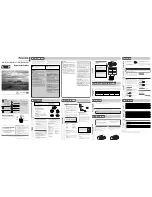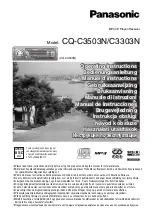
2
k. Discard the receiver's unused plastic cover and base.
3. If the receiver is to be located remotely from the
control in its own plastic enclosure (not in a cabinet):
You will not need the circuit board mounting clips,
grounding lugs and screws included with the receiver.
a. If concealed wiring is to be used, route it through the
rectangular opening at the rear of the base before
mounting. For surface wiring entry, a thin breakaway
area is provided along the base's right edge.
b. Mount the receiver in the selected location. For
greatest security, use all four mounting holes (two
keyslot holes and two round holes) provided in the
plastic base.
c. Affix the receiver's Summary of Connections label to
the inside of the housing cover.
4. Setting the DIP switches (All Receivers):
a. Set the receiver's DIP switch (#2 through #4) to
identify the receiver's address (refer to the DIP switch
chart in Figure 2).
b. Verify that DIP switch #1 is in the OFF position.
c. Set DIP switch #5 according to the following chart.
DIP SWITCH #5
For . . .
Set to . . .
Commercial Fire Applications
ON
Non-commercial Fire Applications
OFF
NOTES:
•
If multiple receivers are used on one control, DIP
switch #5 must be set to the same position on all
receivers.
•
DIP switch #5 reduces sensitivity during
supervision message reception. For commercial fire
applications, DIP switch #5 must be in the ON
position.
5. Insert the wiring plug (with 4 flying leads) into the
mating socket on the receiver (see Figure 2 for socket
location). Connect the 4 wires to the control's
corresponding keypad terminals (see “Interface Wiring”
in the SPECIFICATIONS section).
6. Install the antennas in the right-hand terminals of the
two terminal blocks at the upper edge of the circuit
board, one into each block’s right-hand terminal, and
tighten the screws to secure them.
Caution: Avoid mounting the receiver antennas against
a metal surface.
7. Proceed with any programming of the control that
may be necessary for RF operation, and the
installation of the system's wireless transmitters,
as described in the control's installation and setup guide
and the transmitter's installation instructions.
NOTES:
•
The receiver can support up to 16 encrypted wireless
transmitters (keys). The total quantity of wireless
keys (encrypted and unencrypted) that can be used is
determined by the control panel.
•
Wireless key buttons must be enrolled to zones in the
control panel via zone programming first. If the
wireless key is to be used for arming and disarming
the VISTA-40 and up, a user number must then be
assigned to the wireless key via user programming. If
it is not done in this order, you will be unable to
respond successfully to the RF button zone number
prompt in user programming.
•
If more than one receiver is being used and you are
using encrypted wireless keys, we recommend that
you apply power to only one receiver, enroll your
encrypted wireless keys into it, and then remove
power from the receiver. Repeat this process for each
receiver. Only apply power to all receivers after the
encrypted wireless keys have been enrolled into each
receiver.
•
The RED LED located on the receiver's circuit board
should be used as an indicator of strong local radio
frequency interference. If this LED is continuously
illuminated, the receiver should be relocated.
8. Replace the receiver's cover.
ENCRYPTED KEYS
The receiver can support up to 16 encrypted wireless
transmitters (keys) at one time. If the number on the
receiver microprocessor is WAK 4406-4 or higher, the
receiver provides you with the capability to check space
available and/or delete encrypted keys using the procedures
below.
Checking Space Available
The GREEN LED located on the receiver's circuit board
may be used to determine how many more encrypted keys
may be enrolled into the receiver. To determine how many
more encrypted keys may be enrolled:
1. Remove power from the receiver and set DIP
switch 1 to the ON postion.
2. Apply power to the receiver and watch the GREEN
LED. You will see one of the following indications:
a. The GREEN LED blinks the number of spaces that
are free for additional encrypted key enrollment.
b. The GREEN LED is constantly ON, indicating the
receiver is full.
c. The GREEN LED is OFF, indicating no encrypted
keys are enrolled.
3. Place DIP switch 1 back into the OFF position to
return to normal receiver operation.
Deleting
Enrolled encrypted keys may be deleted using the following
procedure:
1. Record the positions of DIP switches 1 through 5.
2. Set DIP switches 1 through 5 to the opposite
positions of their current settings and wait a few
moments. All enrolled encrypted keys will be deleted.
3. Set DIP switches 1 through 5 back to their original
positions as recorded in step 2.
www.PDF-Zoo.com
Summary of Contents for 5881EN Series
Page 5: ...5 NOTES www PDF Zoo com...


























